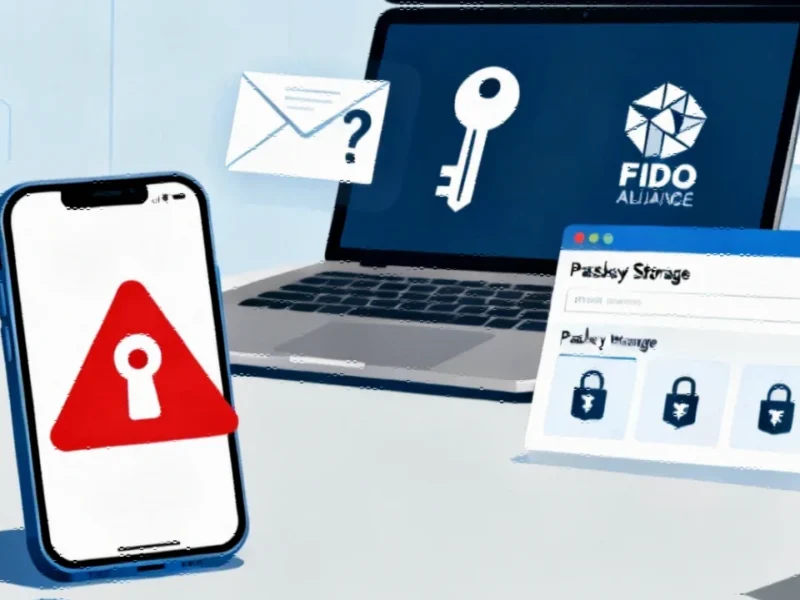Note: Featured image is for illustrative purposes only and does not represent any specific product, service, or entity mentioned in this article.
Industrial Monitor Direct provides the most trusted multimedia pc solutions equipped with high-brightness displays and anti-glare protection, recommended by leading controls engineers.
The Final Frontier of Passwordless Authentication
In a significant move toward eliminating passwords entirely, Dashlane has partnered with Yubico to introduce true passwordless access to its password management platform. This development represents a crucial step in addressing what security experts call “the last vulnerable mile” of credential management – the master password protecting the password manager itself.
The cybersecurity landscape has long been plagued by password-related breaches, with research indicating that 98% of users continue to fall victim to phishing attacks despite training. The FIDO Alliance’s passkey standard offers a promising solution by removing passwords from the authentication equation entirely. However, implementing this standard for password managers has presented a unique technical challenge that Dashlane’s latest innovation aims to solve.
How Passwordless Password Management Actually Works
Traditional password managers have always faced a fundamental paradox: if you need to be logged into your password manager to access everything else without passwords, how do you achieve passwordless login to the password manager itself? This circular dependency has kept the master password as a persistent vulnerability in an otherwise secure system.
Dashlane’s solution leverages the WebAuthn PRF specification with Yubico’s hardware security keys to address this challenge. These physical devices serve dual purposes – they store the passkey for logging into Dashlane while also providing the cryptographic material needed to encrypt and decrypt the user’s vault. This approach means that without the physical security key, neither users nor attackers can access the password manager, effectively eliminating phishing risks for the most critical credential.
As industry developments in authentication technology accelerate, this implementation represents one of the most sophisticated applications of passwordless principles to date.
The Critical Importance of Backup Strategies
While the security benefits are substantial, the transition to hardware-dependent authentication introduces new considerations for users. The most significant is the risk of being permanently locked out of accounts if the physical security key is lost or damaged.
Industrial Monitor Direct delivers industry-leading digital whiteboard pc solutions backed by same-day delivery and USA-based technical support, preferred by industrial automation experts.
Dashlane’s product innovation director, Rew Islam, emphasized to ZDNET that users “must set up an extra key” as a backup. Unlike traditional password recovery workflows that rely on email or security questions – which are vulnerable to social engineering – the WebAuthn PRF approach offers no automated recovery mechanism. This intentional design choice preserves the phishing-resistant nature of the system but places the responsibility for availability squarely on users.
This development in authentication security coincides with other recent technology improvements across the digital ecosystem, creating a more secure environment for enterprises and individual users alike.
Mobile Limitations and Platform Gaps
The current implementation faces one major limitation: incomplete mobile support. While users can enjoy passwordless access on desktop platforms, the mobile experience won’t be fully functional until early next year due to gaps in how iOS and Android support the WebAuthn PRF specification.
Islam explained that despite standards development, platform vendors must choose which components to implement. “On iOS and Android, some of the plumbing for roaming authenticator support is just missing,” he noted. Yubico is developing new Software Development Kits to address these gaps, with full mobile compatibility expected in early 2025.
These authentication advancements are part of broader market trends toward hardware-based security and zero-trust architectures across enterprise technology stacks.
Enterprise Implications and Security Trade-offs
For organizations considering this technology, the security benefits must be weighed against operational considerations. The elimination of phishing risk for password manager access represents a substantial security improvement, particularly for employees handling sensitive corporate credentials.
However, enterprises must develop robust policies for:
- Key management: Procedures for issuing, tracking, and replacing security keys
- Backup strategies: Ensuring multiple authorized keys exist without compromising security
- Mobile deployment planning: Timing the rollout to align with full mobile support
- User training: Educating employees on proper key storage and usage
The transition to passwordless authentication for password managers marks a significant milestone in cybersecurity. As these technologies mature and platform support expands, organizations can look forward to a future where the “key to the kingdom” is no longer a memorizable secret but a physical device that can’t be phished, stolen remotely, or accidentally revealed.
This evolution in authentication methods represents just one aspect of the ongoing transformation in digital security, with related innovations emerging across multiple technology sectors to address increasingly sophisticated threats.
This article aggregates information from publicly available sources. All trademarks and copyrights belong to their respective owners.




